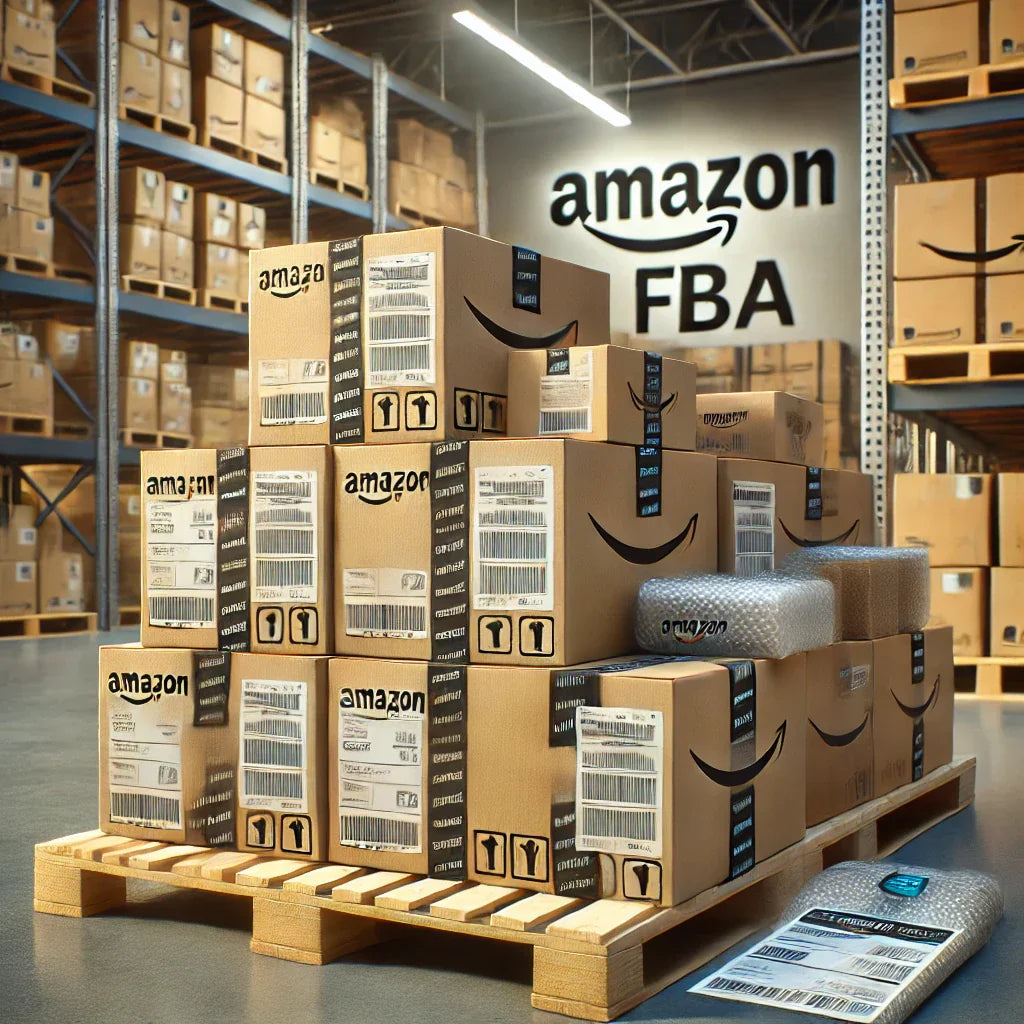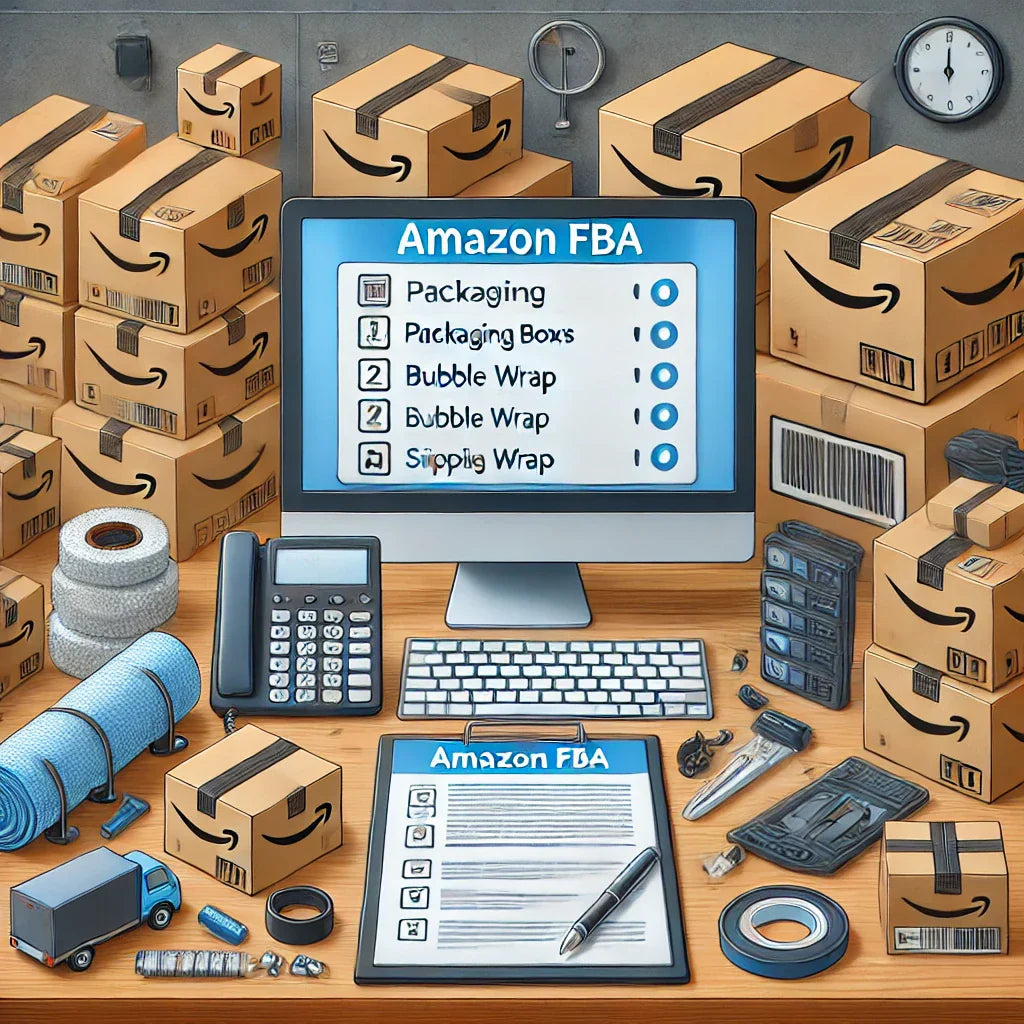To achieve seamless operations and consistent success on Amazon, optimizing inbound preparation is essential for any seller or distributor. Effective inbound prep not only ensures faster processing at Amazon's fulfillment centers but also minimizes potential delays, errors, and costly fees. By understanding Amazon’s specific requirements for packaging, labeling, and inventory organization, businesses can streamline their supply chain, reduce operational headaches, and improve customer satisfaction. In this guide, we’ll cover the best practices and expert tips for Amazon inbound prep, helping you to meet compliance standards and set the foundation for a smoother, more efficient Amazon experience.

Understanding Amazon’s Inbound Preparation Requirements
1. Why Inbound Preparation Matters for Amazon Success
Inbound preparation is a critical component of Amazon’s fulfillment process, ensuring that products are ready for immediate acceptance and stocking within Amazon's Fulfillment Centers (FCs). With millions of sellers on Amazon, competition for visibility, customer satisfaction, and compliance has become more intense. Amazon’s strict inbound prep standards are designed to maintain efficiency and reduce friction in the fulfillment process. Non-compliance can lead to delays, errors in inventory processing, and even increased fees, impacting profitability and seller metrics.
Inbound prep refers to the process of organizing, labeling, and packaging products before they are sent to Amazon’s FCs. This allows Amazon’s team to easily identify and process each item, minimizing issues like mislabeling, damage, or inventory discrepancies. Businesses that prioritize inbound prep can enjoy faster check-ins, reduced chances of rejection or return, and improved customer experiences due to the reliability of their products’ availability and condition.
2. Key Inbound Preparation Guidelines to Follow
Amazon provides clear guidelines for inbound shipments, covering several essential aspects:
- Labeling Requirements: Each unit must have a scannable barcode (UPC, ISBN, or Amazon’s FNSKU). Ensuring labels are correctly applied and legible is crucial.
- Packaging Standards: Amazon has specific packaging guidelines based on product categories. Adhering to these helps prevent damage and avoid compliance issues.
- Shipment Accuracy: Accurate item count and product detail consistency are critical. Mismatches between the shipment contents and the information provided to Amazon can result in rejection.
Step-by-Step Guide to Optimizing Amazon Inbound Prep
3. Preparing Products for Shipment
a. Labeling Products Correctly
Labels are an integral part of the inbound prep process as they allow Amazon to identify each product individually. There are two main labeling types:
- Manufacturer Barcode (UPC, ISBN): This is the original barcode provided by the manufacturer.
- Amazon FNSKU Label: Amazon assigns a unique Fulfillment Network Stock Keeping Unit (FNSKU) to each listing for better traceability. This label is mandatory if products are not under the "Stickerless, Commingled Inventory" setting.
Using the correct barcode type helps prevent inventory mix-ups, ensures compliance, and reduces fulfillment center processing time. Ensure that labels are scannable, durable, and placed on a flat, non-obstructed surface of the product.
b. Choosing Appropriate Packaging
Amazon categorizes products based on size, fragility, and perishability. As a general rule:
- Standard Products: Regular items should be packaged securely to prevent damage during transit.
- Fragile Products: Items that can break easily must be packed with protective materials like bubble wrap and secured in boxes or mailers with “fragile” stickers.
- Oversized or Bulky Items: Larger items need sturdy, reinforced packaging to withstand handling in the FCs.
- Polybagged Products: Items that could leak, be tampered with, or are otherwise delicate should be sealed in polybags that meet Amazon’s requirements.
Consider Amazon’s guidelines for each packaging type, as improper packaging may result in rejections or additional fees.
c. Verifying Shipment Accuracy
Ensuring the accuracy of each shipment is fundamental. Check that all units, product types, and quantities align with the Amazon shipment plan. Using software solutions to automate inventory management and double-check shipment details can help prevent costly errors.
4. Streamlining Inventory Management for Amazon
Inventory management plays a significant role in ensuring your inbound prep is timely and efficient.
a. Real-Time Inventory Tracking
Implement real-time tracking for inventory across warehouses to avoid shortages and ensure consistency in shipment volumes. Amazon’s API integration with inventory management software can help you synchronize data and maintain accuracy.
b. Managing Stock Levels
Efficient stock level management is essential. Overstocking can lead to storage fees, while understocking risks lost sales. Conduct demand forecasting to optimize stock levels, using historical data and seasonal trends to predict inventory needs accurately.
c. Maintaining Accurate Product Data
Correct product data is critical for Amazon listings and inbound preparation. Ensure SKU data, product dimensions, weight, and other specifics are consistent across all internal systems and the Amazon Seller Central platform. Misaligned data can result in errors during shipment check-in.
Common Inbound Prep Errors and How to Avoid Them
5. Labeling Mistakes
Incorrect or missing labels are among the most common errors. To avoid this:
- Conduct quality checks on all labels before shipment.
- Print high-resolution labels to ensure scannability.
- Verify each label corresponds to the correct product.
6. Packaging Inconsistencies
Failing to meet Amazon’s packaging guidelines can lead to damaged goods or rejected shipments. Ensure each item is packaged per Amazon's standards for its category. Use secure padding and appropriate containers for fragile items to minimize the risk of damage during transit.
7. Incorrect Item Quantities
Sending incorrect quantities, either over or under the planned amount, can delay the inbound process. Conduct multiple inventory checks to confirm accuracy, and leverage Amazon’s FBA Inventory Adjustments to rectify any quantity discrepancies.
8. Ignoring Amazon’s Shipping Instructions
Amazon has specific rules regarding how shipments should be organized and labeled on the outside of packages. Pay attention to these requirements to avoid delays:
- Use appropriate Amazon-approved carriers.
- Print and attach the correct shipping labels to each carton.
- Avoid combining multiple shipping plans in one package.
Advanced Tips for Efficient Amazon Inbound Preparation
9. Leveraging Software for Inbound Prep Automation
Automation software can streamline the inbound prep process, making it easier to maintain accuracy and consistency. These tools provide features for inventory management, labeling, demand forecasting, and shipment tracking, all of which reduce human error and improve efficiency.
10. Partnering with an Amazon Prep Center
Amazon prep centers are third-party service providers specializing in preparing inventory for FBA. By partnering with an experienced prep center, you can offload the complexities of labeling, packaging, and shipping compliance. Prep centers are particularly beneficial for high-volume sellers or businesses managing diverse product categories.
11. Regularly Reviewing Amazon Guidelines
Amazon’s requirements for FBA are subject to change, so staying updated with the latest guidelines is essential. Regular reviews can help you avoid compliance issues and proactively adjust to new standards.
Benefits of Optimizing Inbound Prep
12. Improved Inventory Check-in Times
When products meet Amazon’s standards, they are processed and added to available inventory faster. This reduces the time from shipment to shelf, helping your products remain available and ready for purchase.
13. Reduced Operational Costs
Inbound prep optimization can reduce operational costs by minimizing rejections, rework, and delays. Additionally, efficient prep can help prevent costly penalties for non-compliance with FBA requirements.
14. Enhanced Customer Satisfaction
Customer satisfaction often depends on product availability and condition. Optimized inbound prep contributes to fewer stockouts, faster delivery times, and fewer issues with damaged or mislabeled products. This, in turn, builds trust and enhances brand reputation on Amazon.
Key Takeaways for Successful Inbound Preparation
15. Consistency and Accuracy are Essential
Accurate labeling, packaging, and inventory records create consistency in inbound prep. Sellers who prioritize these factors experience fewer disruptions in the supply chain and more seamless integration with Amazon’s FCs.
16. Use of Technology and Data to Drive Efficiency
Employ data-driven tools and software to forecast demand, manage stock levels, and automate routine tasks. This minimizes manual intervention, reduces errors, and increases overall operational efficiency.
17. Regular Review and Adaptation
Amazon’s guidelines evolve, and so should your inbound prep strategy. By regularly reviewing Amazon’s requirements and updating your processes accordingly, you can stay compliant and ensure a smooth inbound process.

Advanced Labeling Techniques for Amazon Compliance
18. Understanding Different Label Types and When to Use Them
While Amazon provides FNSKU labels for all FBA products, there are scenarios where additional labels may be required to avoid mishandling or misidentification. Below are several key label types and tips for correct usage:
- FNSKU Labels: These should be the primary identifier if you’ve chosen Amazon’s FBA. Place them on each individual unit, covering any existing barcodes to avoid scanning errors.
- Case-Pack Labels: For shipments containing multiples of the same product (case-packed products), a case label is essential. Each case must contain the same item in the same quantity. Mislabeling here can lead to time-consuming rework and fees.
- Suffocation Warnings: For polybags and plastic-wrapped items, Amazon requires suffocation warning labels if the bag has an opening larger than 5 inches. Using clear, durable labels that won’t peel off during transport is critical.
- Expiration Date Labels: For products with an expiration date, such as food or supplements, ensure that dates are clearly visible on both the product and the external case packaging.
Label Placement Best Practices
Correct label placement can make a significant difference. Amazon suggests placing labels on the flat side of products and away from edges or corners to ensure barcodes don’t crease. Ensuring labels are printed with high-contrast ink on a white background also improves scannability.
19. Leveraging Amazon Label Services for Efficiency
For businesses that find labeling time-consuming, Amazon’s Label Service is an option to consider. Amazon will apply labels on behalf of sellers at a per-item fee. This service is particularly beneficial for high-volume sellers with limited staff. However, keep in mind the additional cost, which might not be sustainable for low-margin products.
Label Service Limitations
Amazon’s Label Service requires products to arrive with clear UPCs or barcodes for the team to process. If using this service, ensure that each product's UPC is clearly visible and accessible. For custom packaging, avoid using labels that overlap decorative or brand design elements, as Amazon's application may cover these areas.
In-Depth Packaging Guidelines for Amazon
20. Exploring Packaging Types by Product Category
Amazon categorizes items to ensure they meet safety, size, and environmental standards. Here’s a breakdown of packaging requirements by common product types and how to apply them effectively:
- Apparel and Textiles: Items should be polybagged to protect against dust and damage. Include size and SKU labels on the outside of each bag, and for multipacks, a “do not separate” label is recommended.
- Electronics: Electronic items must be well-padded with anti-static bubble wrap, sealed securely, and ideally placed in boxes to prevent movement. Include fragility warnings on the outer packaging.
- Health and Beauty: Fragile items such as cosmetics and skincare products require polybagging and may need shrink-wrapping to prevent leakage.
- Jewelry and Accessories: Small items are often polybagged and placed in sturdy boxes to avoid loss or damage. Use dividers for bulkier shipments to separate each unit.
Understanding these nuances can ensure your products are compliant and less likely to experience delays due to repacking or labeling adjustments in Amazon’s FCs.
21. Minimizing Damage with Durable and Protective Packaging
Reducing damage in transit is a priority, as damaged items not only cost you in replacement but can also lead to negative customer reviews. Here are best practices for protective packaging:
- Box Strength: Use corrugated boxes with appropriate weight limits for heavy items, and avoid reusing boxes as they may be weakened.
- Void Fillers: Include void fillers, like air pillows or crumpled paper, to minimize movement within the box, which can damage fragile items.
- Sealant Quality: Use high-quality tape to secure all box seams. Avoid single layers, especially for heavy shipments, and apply the “H” seal technique (taping down the center seam and edges) for added security.
Taking these precautions will help reduce shipping-related damage, making your inventory more durable and ready for sale upon arrival at Amazon’s FCs.
Scaling Inventory Management for Amazon Growth
22. Implementing Inventory Forecasting Techniques
To maintain optimal inventory levels, forecasting tools and techniques are invaluable. These methods help anticipate demand and avoid issues related to overstocking or understocking.
a. Seasonal and Trend Analysis
Amazon’s seasonality patterns significantly impact inventory needs. For instance, holiday seasons and Amazon Prime Day lead to spikes in certain categories. Leveraging trend analysis tools can help predict when inventory replenishment will be necessary. Using Amazon’s own forecasting tools or third-party software that integrates sales history data allows you to keep pace with demand and minimize stockouts.
b. Safety Stock Calculations
Calculating safety stock levels is essential to account for sudden demand surges or unexpected supply chain delays. Consider the following formula:
Safety Stock=(MaximumDailySalesxMaximumLeadTime)−(AverageDailySalesxAverageLeadTime)Safety \ Stock = (Maximum Daily Sales x Maximum Lead Time) - (Average Daily Sales x Average Lead Time)Safety Stock=(MaximumDailySalesxMaximumLeadTime)−(AverageDailySalesxAverageLeadTime)
This calculation helps in determining the minimum extra inventory to keep on hand to avoid lost sales. Regularly adjusting safety stock as you gather more data ensures it remains accurate.
23. Centralized vs. Decentralized Inventory Models
For businesses with multiple locations or warehouses, choosing between a centralized and decentralized inventory model can impact efficiency and cost.
- Centralized Inventory: Storing all inventory in a single location can reduce complexity in inventory tracking but may lead to slower shipping times.
- Decentralized Inventory: Multiple warehouses located closer to key markets help reduce shipping times but require more complex inventory management to ensure each location is properly stocked.
A hybrid model, using both FBA and FBM (Fulfilled by Merchant) alongside local inventory hubs, often provides a balanced approach to meeting demand while reducing lead times.
Mitigating Common Inbound Prep Pitfalls
24. Addressing Barcode Misalignment Issues
Barcode misalignment is a common issue, often due to inaccurate labeling or misprinted barcodes. This can result in shipments being flagged for correction, causing delays. Here’s how to avoid it:
- Test Scannability: Before sending shipments, scan each type of barcode with a mobile device or barcode reader to verify that all are legible.
- Avoid Obstructions: Place barcodes on a flat surface without folds, seams, or overlaps that could obscure the code.
- Use High-Quality Label Printers: Ensure your printer produces high-resolution images. Blurred or faint barcodes are harder to scan and may result in rejected shipments.
25. Reducing Errors with Shipment Reconciliation
Reconciling shipment quantities with Amazon’s inbound details is crucial, especially if you’re shipping large quantities or multiple SKUs. Consider the following tips:
- Automated Counting: Use software tools that can reconcile shipment counts with purchase orders and Amazon’s records to reduce human error.
- Batch Scanning: Employ batch scanning of items for verification. This can be a simple but effective way to confirm each item matches its listed SKU.
- Documentation: Maintain digital and physical records of shipment details, including item count, SKU list, and packing lists. This documentation helps resolve discrepancies swiftly.
Expert Tips for Maintaining Amazon Inbound Prep Efficiency
26. Staying Ahead of FBA Shipping Deadlines
For critical shopping periods, such as Black Friday or Christmas, Amazon sets specific deadlines for FBA shipments. Failing to meet these can mean your inventory isn’t available during peak sales windows.
- Set Calendar Alerts: Use calendar alerts to remind you of key Amazon deadlines.
- Early Shipments: Ship inventory to arrive a few days before Amazon’s cutoffs to account for any unexpected delays.
- Expedited Carrier Options: During peak periods, opting for expedited shipping can be cost-effective by ensuring products are ready for sale when customers are most active.
27. Cross-Training Team Members on Amazon Standards
Ensuring your team understands Amazon’s guidelines is vital for smooth inbound preparation. Regular cross-training sessions keep everyone aligned and help reduce costly errors.
- Monthly Training Sessions: Implement monthly or quarterly training sessions to review updates to Amazon’s requirements.
- Checklists: Create checklists for labeling, packaging, and inventory reconciliation processes. These help team members verify each step is complete before shipping.
- Quality Control: Assign team members specifically for quality control checks, focusing on areas such as label placement and packaging integrity.
28. Leveraging Performance Metrics for Continuous Improvement
Monitoring key performance indicators (KPIs) related to Amazon FBA can provide insights into your inbound prep efficiency.
- Inbound Performance Metrics: Amazon provides metrics on shipment accuracy, damage rates, and time to receive. Reviewing these can pinpoint issues in your process.
- Rejection Rate: Track how often shipments are flagged for errors. A high rejection rate indicates areas that need improvement.
- Feedback Loops: Regularly analyze Amazon’s feedback on inbound shipments and adjust processes as necessary. Establishing feedback loops ensures continuous improvement and better alignment with Amazon’s requirements.
Leveraging Partnerships and Resources for Inbound Prep Success
29. Working with Third-Party Logistics (3PL) Providers
3PL providers can streamline inbound prep by handling the complex details of Amazon’s FBA requirements, allowing sellers to focus on other growth areas. Here are additional benefits and best practices for leveraging 3PL partnerships:
- Flexibility and Scalability: Many 3PLs offer scalable solutions to adjust to fluctuating demand, making them ideal for sellers with seasonal peaks or rapid growth. This scalability can prevent the need for extra internal resources during high-demand periods.
- Cost Savings on Bulk Shipments: Some 3PLs have established relationships with carriers, enabling them to offer discounted shipping rates, especially for bulk shipments to Amazon’s fulfillment centers.
- Tech Integration for Inventory Tracking: Many 3PLs provide real-time inventory tracking systems that integrate with Amazon’s Seller Central. This integration allows sellers to view inventory status, track shipments, and verify fulfillment efficiency directly, helping with quicker decision-making and minimizing the risk of stockouts.

Advanced Inventory Strategies for Efficient Amazon Inbound Prep
30. Demand Forecasting and Replenishment Timing
Demand forecasting is a crucial aspect of inventory management for Amazon sellers, as it enables businesses to anticipate the quantity and timing of stock replenishments accurately. Using demand forecasting can prevent costly issues such as stockouts and overstocking, which can lead to lost sales or increased storage fees, respectively.
a. Analyzing Historical Sales Data
Start by examining historical sales data from Amazon, including both seasonal and year-round trends. Identify any peaks and troughs that may recur annually, such as during the holiday season or other high-traffic periods like Amazon Prime Day. Amazon’s inventory dashboard provides valuable insights, and integrating third-party inventory management software can further streamline this process.
b. Using Predictive Analytics for Forecasting
Predictive analytics tools can analyze historical data, market trends, and even external factors such as economic indicators to predict future demand more accurately. Tools like Forecast.ly, RestockPro, and Jungle Scout can provide automated forecasting based on previous trends and external factors.
c. Setting Replenishment Alerts
Replenishment alerts within Amazon Seller Central or through third-party software can help you stay on top of your stock levels. These alerts provide notifications when inventory falls below a set threshold, enabling you to act quickly and avoid stockouts. Adjust the thresholds seasonally or based on changes in demand patterns to keep inventory levels in check.
31. Calculating Optimal Safety Stock Levels
Safety stock acts as a buffer to meet unexpected spikes in demand or unforeseen delays in supply chains. Here’s how to calculate and maintain optimal safety stock levels:
a. Safety Stock Calculation Formula
To determine safety stock, consider both lead time variability and demand fluctuations. A commonly used formula is:
Safety Stock=(MaximumDailySales×MaximumLeadTime)−(AverageDailySales×AverageLeadTime)Safety \ Stock = (Maximum Daily Sales \times Maximum Lead Time) - (Average Daily Sales \times Average Lead Time)Safety Stock=(MaximumDailySales×MaximumLeadTime)−(AverageDailySales×AverageLeadTime)
This formula factors in potential changes in sales volume and shipping times, ensuring you always have a buffer for unplanned demand surges.
b. Regularly Adjusting Safety Stock
Recalculate safety stock periodically, especially after major sales events, seasonal peaks, or supply chain changes. This keeps your buffer aligned with current trends and reduces the risk of excess inventory accumulation, which can lead to unnecessary storage fees.
32. Leveraging Automated Inventory Replenishment Systems
Automated replenishment systems are invaluable for sellers managing high volumes or multiple SKUs. These systems utilize algorithms that factor in lead times, historical demand, seasonality, and vendor performance to automate the restocking process. Here’s how to integrate automation into your inventory strategy:
- Integrate with Amazon’s API: Many third-party tools can directly connect with Amazon’s API to access real-time inventory and sales data. This integration enables the system to generate accurate restock recommendations based on current demand.
- Multi-Channel Synchronization: For sellers with inventory across different sales channels (e.g., e-commerce websites, Amazon, and physical stores), automated systems help synchronize inventory levels, preventing accidental stockouts or overstocking across platforms.
- Vendor Lead Time Integration: Incorporate supplier lead times into your system’s calculations. By including expected vendor lead times, your replenishment triggers become more precise, minimizing the risk of stockouts.
33. Inventory Turnover Optimization
Inventory turnover measures how quickly stock sells relative to its average inventory levels. High turnover generally indicates strong sales or optimal stock levels, whereas low turnover can suggest overstocking. Here’s how to optimize turnover rates:
a. Identifying Slow-Moving Inventory
Amazon’s FBA Inventory Age report provides insights into slow-moving items. Products with an inventory age of over 90 days can accrue long-term storage fees. Consider discounting or bundling slow-moving inventory to increase turnover and avoid storage fees.
b. Inventory Performance Index (IPI) Management
Amazon’s Inventory Performance Index (IPI) evaluates how well you manage your FBA inventory. A low IPI score can lead to storage limitations. Improve your IPI score by optimizing inventory levels, removing excess stock, and ensuring a balanced inventory-to-sales ratio.
c. FIFO (First In, First Out) Strategy
To avoid long-term storage fees and prevent goods from aging in storage, implement a FIFO system. Send older inventory to Amazon fulfillment centers first, allowing you to minimize aged stock and improve your IPI score.
34. Diversifying Fulfillment Methods to Enhance Inbound Prep
Amazon sellers typically rely on FBA, but diversifying fulfillment methods with Fulfilled by Merchant (FBM) or Seller Fulfilled Prime (SFP) can enhance flexibility and reduce costs for specific items. Here’s how diversification can improve your inventory management strategy:
a. Using FBM for Slow-Moving or Seasonal Products
For products with low or seasonal demand, fulfilling orders through FBM can reduce storage fees and free up space in Amazon’s fulfillment centers. This approach is particularly useful for oversized or bulky items that incur higher storage costs.
b. Enabling Seller Fulfilled Prime (SFP)
SFP combines the benefits of FBM with Amazon Prime eligibility, allowing sellers to ship directly to customers while maintaining Prime benefits. This can help reduce inbound shipments during peak seasons while maintaining a strong sales presence on Amazon.
c. Leveraging Third-Party Warehouses
Storing inventory in third-party warehouses until it’s ready to be sent to Amazon can help regulate FBA storage costs. Ship items in batches to Amazon based on demand forecasts and restock alerts, keeping storage fees low and reducing the risk of overstocking.
35. Inventory Audits and Reconciliation
Regular inventory audits and reconciliations ensure that records in Amazon Seller Central align with physical stock levels, minimizing the chance of discrepancies. Here’s how to streamline your auditing process:
a. Cycle Counting
Conduct periodic cycle counts of inventory stored both in Amazon fulfillment centers and your own warehouses. Cycle counting allows you to verify stock levels without requiring a full inventory count, saving time and resources.
b. Automated Reconciliation Software
Automated reconciliation tools like InventoryLab and QuickBooks sync with Amazon to compare purchase orders, sales records, and stock levels in real-time. This reduces manual errors and flags discrepancies faster, allowing for quicker resolution.
c. Handling FBA Inventory Adjustments
Amazon occasionally makes adjustments to FBA inventory counts due to mishandling or lost items. Regularly review your FBA inventory adjustment reports to identify these discrepancies and submit claims if Amazon’s adjustments have resulted in a loss of stock.
36. Implementing a Backup Inventory Strategy
A backup inventory strategy is essential for maintaining consistent availability, especially during high-demand periods or unexpected supply chain disruptions. Here’s how to set up an effective backup plan:
- Store Backup Inventory at a 3PL: A third-party logistics provider can serve as a secondary storage location. If inventory in Amazon’s fulfillment centers runs low, you can quickly ship additional stock to meet demand.
- Split Inventory Across Multiple Warehouses: For sellers with extensive operations, splitting inventory across several fulfillment centers reduces risk in case of regional disruptions, such as weather-related delays or capacity limitations.
- Stockpile Essentials for Peak Seasons: During peak seasons, set aside a certain percentage of backup inventory to maintain stock levels if demand surges unexpectedly. This ensures that you don’t miss sales opportunities due to stockouts.
Optimizing Lead Times for Faster Turnaround
37. Reducing Supplier Lead Times
Supplier lead times can significantly impact inventory levels and restocking schedules. By working closely with suppliers to reduce lead times, you can improve the efficiency of your Amazon inbound prep process.
a. Collaborating with Suppliers for Improved Efficiency
Build a strong relationship with suppliers to negotiate faster production times or priority manufacturing during peak seasons. Clearly communicate your demand forecasts to help suppliers plan for your production needs.
b. Alternative Supplier Sourcing
Consider sourcing backup suppliers who can meet demand quickly if your primary supplier encounters delays. Alternative suppliers reduce dependency on a single source and can help manage lead times, especially during peak sales periods.
c. Bulk Ordering and Consolidated Shipping
For products with consistent demand, placing larger orders and shipping in bulk can reduce lead times, as it reduces the frequency of replenishment orders. This can be especially effective for products with stable sales throughout the year.
38. Streamlining Logistics for Timely Inbound Prep
Efficient logistics are key to reducing lead times and maintaining a consistent flow of stock into Amazon’s fulfillment centers. Consider these strategies to improve logistics management:
a. Cross-Docking to Minimize Handling Time
Cross-docking allows shipments to move directly from the supplier to Amazon’s fulfillment centers with minimal storage time. For high-demand products, cross-docking can save on warehousing costs and accelerate the inbound process.
b. Freight Forwarding for International Shipments
For international sellers, freight forwarding can simplify the complexities of cross-border logistics. A reliable freight forwarder will handle customs clearance, paperwork, and compliance, reducing potential delays.
c. Expedited Shipping Options for Urgent Replenishment
During peak seasons, using expedited shipping for urgent shipments can reduce lead times and ensure that high-demand items reach fulfillment centers quickly. While more costly, this option is valuable for maintaining stock availability when demand surges unexpectedly.
39. Regularly Reviewing and Adjusting Inventory Strategies
Regular reviews allow you to fine-tune your approach, making necessary adjustments based on recent data and aligning your inventory levels with changing demand patterns. Here’s how to maintain a proactive review process:
- Quarterly Supplier Evaluations: Assess supplier performance at least quarterly, focusing on lead times, quality consistency, and adherence to your specified requirements. This allows you to identify and address any issues that could impact your inbound prep timelines.
- Feedback from Amazon Metrics: Amazon provides various performance reports, including feedback on shipment compliance, damage rates, and overall inventory health. Review these metrics to uncover potential issues in your preparation or shipping process, enabling you to resolve inefficiencies early.
- Benchmarking Against Competitors: Conduct regular benchmarking to ensure your inbound and inventory strategies remain competitive in terms of fulfillment speed, cost-effectiveness, and availability. Use Amazon’s Best Sellers Rank (BSR) as an indirect benchmark, as it reflects stock and sales consistency among similar products.
40. Preparing for Amazon’s Changes in Inventory and Fulfillment Policies
Amazon frequently updates its fulfillment and inventory management policies, making it essential for sellers to stay informed and adapt accordingly. Here’s how to manage these policy shifts effectively:
a. Staying Updated on Amazon’s Policy Announcements
Monitor Amazon’s Seller Central announcements regularly. Important updates, like changes in FBA fee structures, labeling requirements, or storage policies, can significantly impact your cost calculations and operational strategies.
b. Adjusting Inventory Strategies to Avoid Policy Penalties
When Amazon changes its storage fee structures or introduces new FBA guidelines, adapt your inventory strategy to avoid penalties. For example, if Amazon increases storage fees for long-term inventory, it may be advantageous to shift slower-moving products to FBM or a 3PL until demand picks up.
c. Building Flexibility into Your Prep Process
Create a flexible inbound prep process that can quickly adjust to policy changes. For example, if Amazon mandates new labeling requirements, having a dynamic labeling system with adjustable templates and batch-printing capabilities will streamline compliance with minimal disruption.
41. Establishing Emergency Contingencies for Inbound Prep
A robust contingency plan for inbound prep helps mitigate the risks associated with unforeseen disruptions, from shipping delays to sudden demand surges. Here’s how to establish an emergency response for inbound preparation:
- Alternative Prep Centers: Keep a list of backup Amazon prep centers or 3PLs that can step in if your primary facility encounters delays or other issues.
- Flexible Shipping Carriers: Maintain relationships with multiple carriers to allow for flexibility in the event of delays or issues with one provider. Some Amazon sellers contract both standard and expedited services to handle surges or urgent shipments as needed.
- Predefined Rapid Restock Plans: Set up an emergency restocking plan, including buffer stock held in third-party locations or local warehouses, that can be deployed rapidly in case of a stockout or a major demand spike.

Leveraging Technology for Enhanced Inbound Prep Efficiency
42. Utilizing Advanced Inventory Management Software
High-quality inventory management software (IMS) automates numerous aspects of inbound prep, from demand forecasting to real-time tracking. Here’s how to harness the power of these systems:
a. Real-Time Inventory Tracking and Reordering
With real-time data on stock levels, IMS can trigger automatic reorder alerts when stock levels reach a predefined threshold, ensuring timely restocks. Some software, such as TradeGecko or Zoho Inventory, offers additional benefits like multi-channel integration, which allows for centralized control across all sales platforms.
b. Data-Driven Inventory Optimization
IMS platforms often come with powerful analytics tools, allowing you to track inventory turnover rates, seasonal patterns, and overall supply chain performance. Use these insights to identify high-performing SKUs, adjust stocking strategies, and make data-backed restocking decisions.
c. Integrating with Amazon’s API for Seamless Data Flow
Integrate your inventory software with Amazon’s API to synchronize product listings, orders, and stock levels automatically. This reduces manual data entry, minimizes errors, and ensures that your Amazon listings reflect current stock availability accurately.
43. Automating Label Printing and Inventory Documentation
Automating labeling and documentation processes streamlines your inbound prep, reducing manual labor and ensuring compliance with Amazon’s requirements.
- Automated Label Printing: Tools like Bartender Label Software or PrintNode can print labels directly from your inventory management software, saving time and improving accuracy. These tools allow custom templates for FNSKU, case, and compliance labels.
- Document Management Systems: Use document management software like DocuWare or SharePoint to store and organize critical inventory documents, such as invoices, purchase orders, and compliance certifications. Digitizing records reduces paperwork and allows for easy access when you need to resolve disputes or verify compliance.
44. Implementing Artificial Intelligence (AI) for Predictive Analytics
Artificial intelligence (AI) can enhance your inbound prep by identifying patterns and making predictive recommendations based on historical and market data. Here’s how AI technology can optimize your process:
- Predictive Demand Forecasting: AI-driven tools analyze both internal data (like past sales) and external factors (such as market trends or economic indicators) to forecast demand accurately. Tools such as Forecast.ly or RestockPro can predict the quantity and timing of restocks to ensure stock availability without excessive overstock.
- Inventory Optimization Algorithms: AI algorithms can help balance stock across multiple warehouses, avoiding overstock in one location while others run low. This reduces storage costs and minimizes the risk of regional stockouts.
- Enhanced Demand Sensing: AI models that use machine learning can quickly detect changes in demand trends, allowing you to adjust inventory strategies more promptly than with traditional demand sensing techniques.
Long-Term Inbound Prep Optimization Strategies
45. Building a Strong Supplier Relationship for Better Lead Times
Maintaining a strong relationship with suppliers can improve lead times and ensure they prioritize your orders, especially during peak demand periods. Here’s how to foster better supplier relations:
- Transparent Communication: Keep suppliers informed of your demand forecasts, particularly before peak seasons, so they can adjust production schedules to meet your needs.
- Incentivizing Prompt Delivery: Some businesses offer incentives for on-time deliveries or early restocks, such as small bonuses or larger order commitments. This encourages suppliers to prioritize your orders and avoid delays.
- Regular Performance Reviews: Evaluate suppliers periodically to assess lead time consistency, quality standards, and compliance with Amazon’s requirements. Share this feedback openly with suppliers to foster improvements.
46. Implementing SKU Rationalization for Inventory Optimization
SKU rationalization, or the process of streamlining your product assortment, helps improve turnover rates and reduces the complexity of inbound prep. Here’s how to conduct SKU rationalization effectively:
a. Analyze Product Profitability
Review the profitability of each SKU, considering factors like production costs, demand levels, and Amazon fees. Removing low-performing or low-margin items reduces the burden on your inventory system and allows you to focus on high-value products.
b. Consolidate Low-Demand SKUs
Consider consolidating SKUs that are similar or redundant. For example, if two items serve similar customer needs, merging them into a single SKU can streamline inventory and reduce storage fees.
c. Seasonal SKU Rotation
Implement a seasonal SKU rotation strategy to phase out certain items during low-demand periods and reintroduce them during peak times. This rotation keeps inventory fresh and maximizes storage utilization.
47. Regular Inventory Audits and Physical Reconciliation
Inventory audits verify that stock levels in Amazon’s system match actual inventory on hand. Regular physical reconciliations can prevent costly stock discrepancies, as well as potential IPI score penalties.
- Quarterly Audits: Schedule quarterly physical inventory audits to verify stock levels and correct any discrepancies. This is especially important if your inventory fluctuates due to seasonal demand or rapid sales growth.
- Daily Cycle Counting for High-Value Items: For high-value or fast-moving items, perform daily cycle counts to ensure accuracy. Focus on SKUs that experience frequent stockouts or show consistent discrepancies to address issues promptly.
- Automated Reconciliation Reports: Use Amazon’s reconciliation reports, such as the “Lost & Damaged Inventory” report, to identify and resolve discrepancies. Keep detailed records of claims and reimbursements to ensure your data remains accurate.
48. Conducting Regular FBA Policy Compliance Checks
Ensuring compliance with Amazon’s FBA policies protects your IPI score, reduces potential fees, and maintains seamless inventory flow. Here’s how to stay on top of FBA compliance:
- Policy Update Alerts: Set up alerts for Amazon Seller Central updates so you are informed immediately of any changes in FBA policies. Integrate policy updates into your inbound prep process to prevent errors and penalties.
- Regular Team Training: Conduct quarterly training sessions with your team to review Amazon’s FBA standards, including labeling, packaging, and inventory limits. Make these sessions mandatory for new hires and for team members involved in the inbound prep process.
- Third-Party Audits: Occasionally engage a third-party audit firm to assess compliance in your Amazon operations. Auditors can offer insights into areas of improvement and help ensure long-term adherence to Amazon’s standards.

Conclusion: Your Path to Amazon Inbound Prep Success
Optimizing inbound preparation for Amazon requires diligence, accuracy, and adherence to Amazon's evolving requirements. By focusing on efficient labeling, packaging, and inventory management, and leveraging automation where possible, you can streamline the inbound prep process and achieve faster check-ins, reduced operational costs, and enhanced customer satisfaction. For sellers and distributors, these best practices are the foundation of successful fulfillment operations on Amazon, providing a competitive edge in a fast-paced marketplace.
Read More
- The Essential Guide to Inbound Prep for Amazon Sellers
- Understanding Amazon's Inbound Prep Requirements: A Step-by-Step Guide
- Inbound Prep Services for Amazon FBA: What Sellers Need to Know
- Common Mistakes in Amazon Inbound Prep and How to Avoid Them
- Amazon Inbound Prep: Streamlining Your Process for Faster Fulfillment
- Why Inbound Prep is Crucial for Amazon Success: An Overview for Sellers







